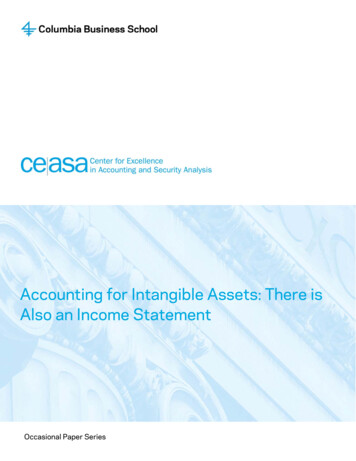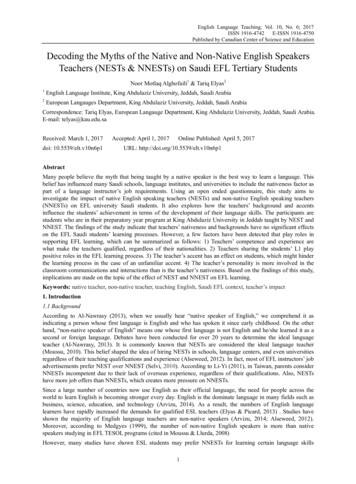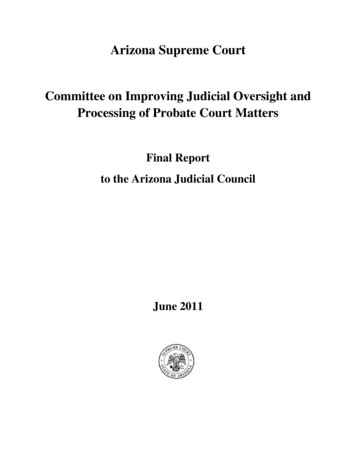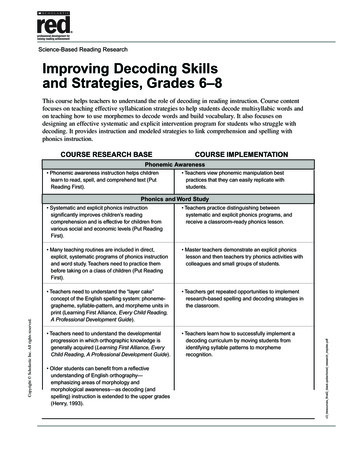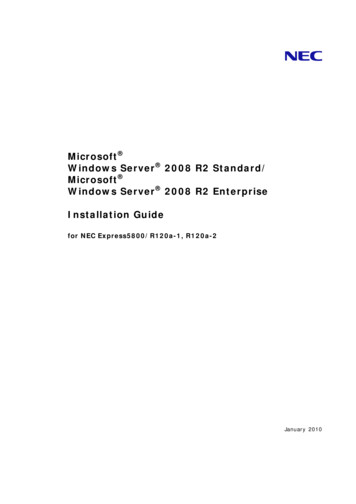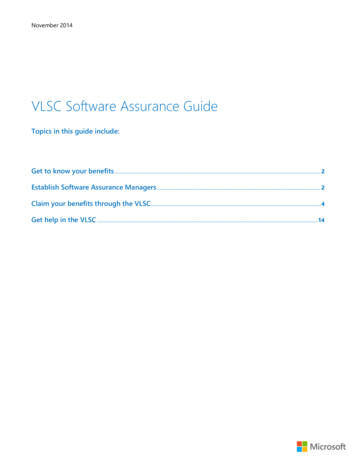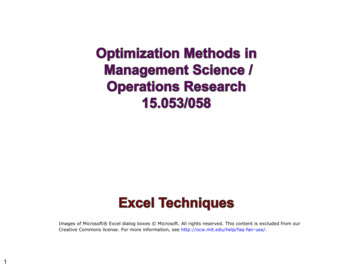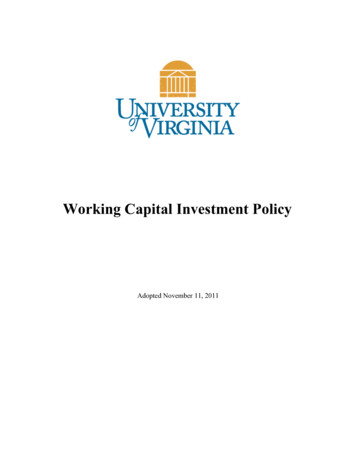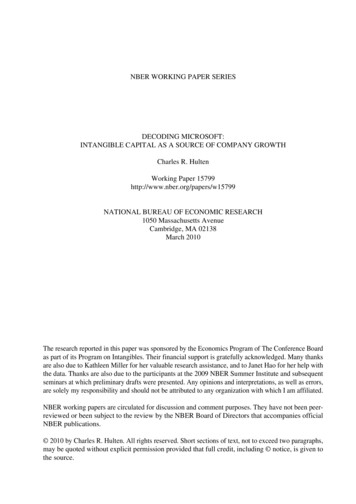
Transcription
NBER WORKING PAPER SERIESDECODING MICROSOFT:INTANGIBLE CAPITAL AS A SOURCE OF COMPANY GROWTHCharles R. HultenWorking Paper 15799http://www.nber.org/papers/w15799NATIONAL BUREAU OF ECONOMIC RESEARCH1050 Massachusetts AvenueCambridge, MA 02138March 2010The research reported in this paper was sponsored by the Economics Program of The Conference Boardas part of its Program on Intangibles. Their financial support is gratefully acknowledged. Many thanksare also due to Kathleen Miller for her valuable research assistance, and to Janet Hao for her help withthe data. Thanks are also due to the participants at the 2009 NBER Summer Institute and subsequentseminars at which preliminary drafts were presented. Any opinions and interpretations, as well as errors,are solely my responsibility and should not be attributed to any organization with which I am affiliated.NBER working papers are circulated for discussion and comment purposes. They have not been peerreviewed or been subject to the review by the NBER Board of Directors that accompanies officialNBER publications. 2010 by Charles R. Hulten. All rights reserved. Short sections of text, not to exceed two paragraphs,may be quoted without explicit permission provided that full credit, including notice, is given tothe source.
Decoding Microsoft: Intangible Capital as a Source of Company GrowthCharles R. HultenNBER Working Paper No. 15799March 2010JEL No. O32,O47ABSTRACTA great deal of research has been devoted to the effects of technical change on economic growth. Lessattention has been given to the factors driving the growth of the technological innovators themselves.This paper examines the case of one of the central contributors to the IT revolution, the MicrosoftCorporation. The company’s sources of growth are estimated using the conventional Solow-JorgensonGriliches “residual” model, expanded to include investments in product research and development,sales and marketing, and organizational development (collectively termed the company’s “intangible”capital). The picture of Microsoft that emerges from this analysis is a story about the successful useof knowledge inputs to produce knowledge outputs. It is also a story of the importance of productinnovation, rather than process innovation, as a source of total factor productivity growth. The theoreticalunderpinnings of the empirical analysis are also examined, and a model is sketched in which the neoclassicalgrowth accounting framework is linked to the theoretically messier world of the Schumpeterian competitorvia the Berndt-Fuss theorem on capital utilization.Charles R. HultenDepartment of EconomicsUniversity of MarylandRoom 3105, Tydings HallCollege Park, MD 20742and NBERhulten@econ.umd.edu
DECODING MICROSOFT:INTANGIBLE CAPITAL AS A SOURCE OF COMPANY GROWTHThe revolution in information technology emerged in full force in the 1980s, withthe advent of personal computers, mobile cellular telephones, followed somewhat laterby the internet and a host of other IT products. The revolution was based on advancesin technical knowledge, augmented by creativity and luck, and it involved theexpenditure of considerable resources. Many companies entered the IT tournament,but only a few emerged with the prizes.The Microsoft Corporation was one of the fundamental contributors to the ITrevolution, and one of the principal winners. Microsoft began its life as a publicly-tradedcompany in 1986 and has grown to dominate the market for computer operatingsystems and office application suites. Revenues grew from 198 million in 1986 to 44,282 million in 2006, and the stock price increased from its offering value of 21 pershare (about 0.08 when adjusted for stock splits) to a peak of around 50 in late 1999(again, split adjusted), and is now around 28.This remarkable growth parallels the similarly phenomenal growth of informationtechnology itself. Business investment expenditures for software grew from 26 billionin 1986 to 227 billion in 2007, while computer investment grew from 34 to 94 billionover the same period. Microsoft was at the center of this growth story, riding the waveof demand for software created by the structural shift toward IT. However, there is moreto the Microsoft story than the surge in demand for software. This paper examines the“supply” side drivers of Microsoft’s growth, using the same general sources-of-growthapproach the Bureau of Labor Statistics (BLS) uses for its macroeconomic productivityestimates. But, unlike the BLS approach, this research follows Corrado, Hulten and1
Sichel (CHS, 2009) in adding the investment in intangibles to the list of inputs andoutputs.1 The list of intangibles includes product research and development, sales andmarketing, finance and management, all of which provide the intellectual-propertyinfrastructure of a company like Microsoft.The main data used to estimate the sources of Microsoft’s growth are obtainedfrom the company’s publicly available financial reports. These data are reported in thecurrent dollars of each year, and need to be converted to inflation-adjusted (‘real’) pricesto be useful for growth analysis. The company’s own-account intangible assets mustalso be estimated, since current accounting practice does not include this category ofcapital on the firm’s balance sheet. Finally, the estimates must be put into a sources-ofgrowth format.The main result emerging from the analysis is that the company has a lot morecapital than is apparent from its financial statements. Conventional accounting practiceputs Microsoft’s balance sheet assets at some 70 billion in 2006, but the estimates ofthis paper reveal an additional 66 billion in missing intangible capital. These additionalassets cause shareholder equity to jump from 40 billion to 106 billion. When theadditional equity is counted, the rate of return to equity investors is found to bedramatically lower, falling from the conventional rate of 31.4 percent to an intangiblescorrected 15.7 percent.1The analysis of Microsoft’s growth in this study is largely empirical. However, theoretical issues cannotbe avoided. The sources-of-growth model used in this paper presumes perfectly competitive markets,little uncertainty about the outcome of investments, and is strongly oriented to the actual making of goodsand services. None of these assumptions fit the case of Microsoft, which operates more like aSchumpeterian competitor in a world of uncertainty and product competition. One objective of this paperis to sketch a version of the Schumpeterian growth framework that is appropriate for Microsoft, but whichcan be linked back to the sources-of-growth model.2
The “missing” intangible capital is also important for understanding the rapidgrowth of Microsoft’s real output. The company grew at a healthy average annual rateof 30 percent over the period 1988 to 2006, driven by rates total factor productivity(TFP) growth and capital formation that greatly exceed those of the nonfarm businesssector as a whole. Intangible capital accounted for more than 40 percent of Microsoft’sgrowth, while the next largest source of growth, TFP, accounted for just 20 percent.Within TFP, only about a fifth of this 20 percent increase was due to improvements inthe efficiency of the production process (the usual interpretation of TFP), while the restwas due to improvements in the quality of Microsoft’s output. Investment in ITequipment was of negligible importance. The story of Microsoft that emerges from thisanalysis is a story about intangible intellectual capital and, in particular, about thesuccessful use of ‘knowledge’ inputs to produce ‘knowledge’ outputs.II. Macroeconomic Growth and the IT RevolutionThe ability of an economy to grow its real GDP depends on how successful it isin growing the inputs of capital and labor needed to produce the product, and on itsability to increase the productivity of those inputs. Economists have studied thisprocess using a variety of techniques, but the one that has gained the greatest tractionis the “sources-of-growth” model developed by Robert Solow (1957), Dale Jorgensonand Zvi Griliches (1967), and others.2 This is the model used by the BLS in itsproductivity program, and by the OECD. The basic idea is to assume that there is a2The development of this model is surveyed in the recent article by Hulten (2009). A large body ofresearch has evolved from these early contributions, as represented by the recent research by van Ark et.al. (2008) on the growth of European economies.3
stable link between input and output (the production function) and to use this link todivide the growth rate of output between (1) the growth rates of a list of inputs (capitaland labor in the macro economy), each weighted by its relative contribution to output,and (2) an unexplained residual which is interpreted as the change in the jointproductivity with which the inputs are used (TFP).Table 1 shows the BLS estimates for the non-farm business economy of the U.S.over the years 1973 to 2003.3 These estimates tell the story of the growth of this sectorand highlight the roles played by IT-related inputs. In the high-growth period from 1995to 2003, IT and software were responsible for 34 percent of sectoral growth, andchanges in labor composition toward more educated workers accounted for another 13percent. Traditional ‘bricks-and-mortar’ capital, that is, plant and equipment, playedonly a minor role. The largest individual contributor to growth was TFP (45 percent),Because TFP is measured as a residual, it sweeps together many factors not directlyrelated to technology, like variations in capacity utilization. However, over longer timeintervals in technologically advanced countries, it captures the diffusion of technicalknowledge and organizational know-how.Table 1 also shows the productivity slowdown of the early 1970s to the mid1990s and the pick-up in productivity that followed. The growth rate of output perworker nearly doubled between the two periods, driven by the change in TFP growth3Following the BLS convention, the growth of output and capital is shown in this figure in per workerterms. This is essentially the same growth accounting story as when output and capital are representedalone. When the focus is on individual companies, as later in this paper, the latter framework ispreferable, because it more naturally represents the role of other inputs like materials, energy, andpurchased services.4
(57 percent of the pick-up) and the growth in IT and software (36 percent of the pickup).There is, however, something missing from this picture. In the cover story ofBusinessWeek in February 2006, Michael Mandel observed:“Grab your iPod, flip it over, and read the script at the bottom. It says: ‘Designed byApple in California. Assembled in China.’ Where the gizmo is made is immaterial to itspopularity. It is great design, technical innovation, and savvy marketing that have helpedApple Computer sell more than 40 million iPods. Yet the [U.S. national accountsdoesn’t] count what Apple spends on R&D and brand development, which totaled atleast 800 million in 2005.”The same observation applies to Microsoft keyboards (“Designed in Redmond, WAUSA Made in China”). The “great design” and “savvy marketing” are not in the BLSproductivity numbers, nor, until recently, are they in the GDP estimates.4 They are,however, as much a part of the ‘knowledge revolution’ as computers and software, and,they are important. Estimates by Nakamura (2001) and Corrado, Hulten, and Sichel(2005) suggest that U.S. businesses invest as much in their intangibles as they do intheir plant and equipment (including IT).CHS put the amount of ‘missing’ intangibleinvestment at more than 1 trillion in the early 2000s, and the corresponding amount ofintangible capital at 3.4 trillion.What exactly are these intangibles assets? In the CHS studies, they includeR&D, both scientific and non-scientific, software, worker-training, brand equity, andorganizational development. They do not affect the current volume of output produced,and differ, in this regard, from tangible plant and equipment. Instead, they typically4Mandel’s comment refers specifically to the U.S. national accounts produced by the Bureau ofEconomic Analysis (BEA), but applies with equal force to financial accounting practice. BEA has recentlymoved to capitalize R&D (Robbins and Moylan (2007)), but financial accounts still omit most of theintangible capital produced within a company.5
involve the development of specific products or processes, or are investments inorganizational capabilities, creating or strengthening product platforms that position afirm to compete in certain markets (and, they may be play both roles simultaneously).Intangibles frequently involve the development and use of knowledge (technology,organizational know-how, business models) and are therefore “non-rival,” in the sensethey can often be used by more than one firm (the source of appropriability problems) orhave multiple uses over time by the same firm (one source of cost allocation problems).They are predominantly developed within the firm that is the primary user, and they formthe intellectual-property of the firm. Finally, they are called “intangibles” because that is,in fact, what they are. They lack a physical embodiment like other inputs, and aretherefore not directly visible like buildings and equipment. The latter can beenumerated and their age and condition assessed, but in what units do you measureknowledge or expertise, and how do you know when intangibles are no longer in use?This lack of visibility is one of the reasons that they are excluded from financialaccounts, and it is the source of skepticism about their status as capital.5Outlays for business intangibles have increased sharply over time. At the 2000peak, intangible investments claimed about 10 percent of non-farm business revenues,up from 2 percent five decades earlier. The
Sichel (CHS, 2009) in adding the investment in intangibles to the list of inputs and outputs.1 The list of intangibles includes product research and development, sales and marketing, finance and management, all of which provide the intellectual-property infrastructure of a company like Microsoft. The main data used to estimate the sources of Microsoft’s growth are obtained from the company .
